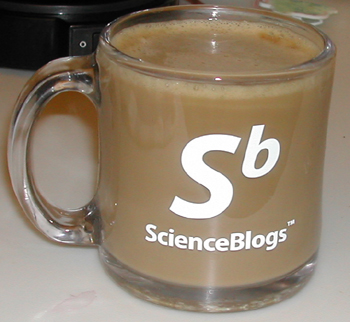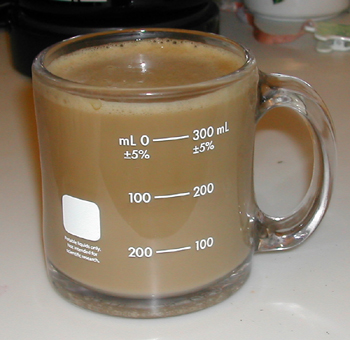
However, it would seem that the disclaimer is ambiguous. Otherwise, why would my better half and I disagree about what the disclaimer means?
It’s not like either of us is the sort to propose an alternate interpretation just to be difficult. Honest!
Anyway, here’s the front of the mug. It’s a nice design. (And if you have a serious hankering for a mug like this one, my understanding is that they are currently being given away to folks who subscribe to Seed. I don’t know that any are available yet on eBay, but surely it’s just a matter of time.)

For my money, though, it’s the back of the mug that’s really special.
The approximate volumes (plus or minus 5%) are marked on the side of the mug, as if it were a beaker or an Erlenmeyer flask! Granted, I don’t recall any of the beakers or Erlenmeyer flasks I used in the lab having the approximate volumes marked in ascending and descending order, but that could just be my memory going.
Possibly both scales are given to accommodate the glass-half-full people and the glass-half-empty people.
Another nice touch was that rounded rectangular blob of white, where one might use a grease pencil or a Sharpie to mark the mug, perhaps to convey information about its contents (“25% soymilk by volume”).
Right under that blob of white is the disclaimer.

The “potable liquids only” part seems straightforward. It’s a mug, after all. Mugs are intended to deliver drinks to one’s mouth. Drinking a non-potable liquid is often a bad idea. (Ask Socrates. Oh wait, you can’t — he died from that hemlock he drank.)
“Not intended for scientific research” was the part where my better half and I drew different inferences.
Said I, “They don’t want you putting the mug over a Bunsen burner (although when was the last time you used one of those in the lab?). Or maybe they are making even less of an assurance than usual that the approximate volumes marked on the side are even close to accurate. Or they want to make extra sure that you don’t get your labware and your tableware comingled. You don’t want experimental reagents getting into your coffee, or your coffee to contaminate your experiment.”
Said my better half, “This is a mug. Mugs convey messages about the people drinking from them. ‘World’s Best Grampa’ isn’t a description intended to apply to the mug itself, but rather to the person drinking from the mug.”
“And?” I asked.
“That would mean that the person drinking from this mug is being identified as ‘Not suitable for scientific research’. Someone with no future as a researcher. A person who ought to stay out of the lab.”
“Nah, it couldn’t mean that,” I scoffed. “Maybe it’s indicating that the beverage in the mug is for drinking rather than analyzing, but I don’t think the mug is dissing the person drinking from it.”
“You seem pretty sure of yourself,” said my better half skeptically.
“I refuse to see my mug as making a judgment about by abilities,” I replied.
“Go on with your optimism.”
“When one is properly caffeinated,” I said, “it’s easier to be optimistic.”

I’ve used beakers with the gradients going both up and down. They are rare, though.
Disclaimer is for lab geeks not to trust the precision of the markings of the mug, i.e., not to try to use it in the lab as a real measuring device just because you’re a geek and think that would be the coolest thing on Earth to do….
The disclaimer applies neither to the person using the mug, nor to the mug itself, but to the contents of the mug. Which seems reasonable. My mug contains greenish slimly things I presume are new life forms. They seem to be immune to frequent spells of hot coffee. And I then drink the solution. Attempting to analyse the liquid. or the mug’s residue, would probably involve the invention of several new branches of biology, not to mention hyperdimensional physics and public health.
It just means that you’d have to be a mug to take it in the lab….
Wow, I would love a mug like that!
ScienceBlogs would NEVER label people as “not suitable for scientific research”! So it must apply to the mug.
Blf’s comment makes my stomach queasy…
…I once worked with a guy who never ever ever washed his coffee mug. It had originally been white. Looking at it made you feel sorry you’d ever let coffee get near your teeth – at least, lab coffee.
I wish my mug would hurry and get here!
“I don’t recall any of the beakers or Erlenmeyer flasks I used in the lab having the approximate volumes marked in ascending and descending order”
“I’ve used beakers with the gradients going both up and down. They are rare, though.”
Rare? Pyrex(tm) beakers are always marked like that; always have been (AFIK). Exhibit A.
Actually, the disclaimer refers to the white blob itself.
Doesn’t mean it can’t be used in scientific research with the proper application. Such as in a study designed to determine which percentage of the population has an adverse reaction to a new artificial sweetner.
Or maybe they are making even less of an assurance than usual that the approximate volumes marked on the side are even close to accurate.
Sounds like a good excuse to bring out the volumetric glassware and find out!
Obviously not designed by a mathematician – Paul Erdös has a famous definition of a mathematician as “a machine for turning coffee into theorems”, which suggests that a mug something like this would be essential for research. The disclaimer I’ve seen on mathematicians’ mugs is “Caution – Not a Doughnut”.
I may have subscribe to Seed just to get one of these–my dad is always driving my mother crazy when he helps her cook, because he insists on compensating for the meniscus, etc., while measuring. Yeah, he’s a recovering chemist. Too bad he doesn’t drink coffee…